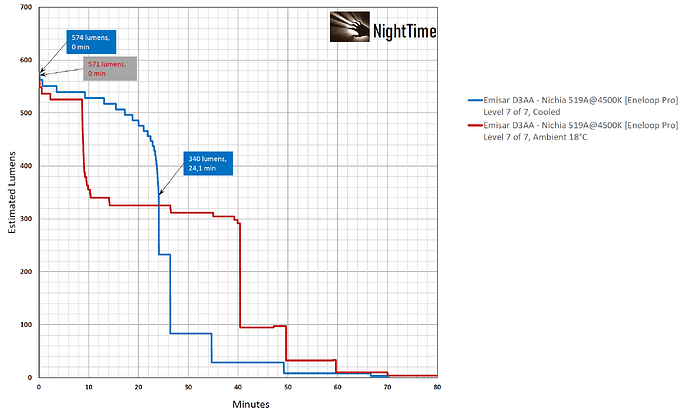Before diving into the results, please take a moment to read through the following key points to understand the context of this comparison.
Introduction
I purchased two versions of the Emisar D3AA:
- 4000K dedomed Nichia 519a : My actual go-to EDC light.
- 4500K domed Nichia 519a : Bought for science

I was interested to find out whether the D3AA can rival what I consider the most efficient AA light ever: the Zebralight SC5w MK II. While I don’t claim one is outright better than the other, the SC5w has set a high bar for NiMH efficiency.
To level the playing field, I selected the most efficient 4500K emitter Hank offers: the domed Nichia 519a as suggested by TheFreeman. As far I as know, the XP-L2 found in the SC5w is a bit more efficient than the 519a so it’s not completely fair for the D3AA. I know the SC5w is discontinued, but I have no plan to buy a SC54c either.
Testing Methodology
Since sustained brightness is crucial to me, I tested both the host and driver independently. As you know, there are various strategies to help a host manage temperature, such as using specific materials, employing active cooling, adjusting the temperature ceiling, adding cooling fins, and of course the mass itself. However, not all drivers are created equal, so even if you cool down the host, a low-quality driver won’t sustain any level. By running temperature-sensitive levels with and without active cooling, I obtain valuable information about both the host and the driver.
For Anduril 2 (D3AA):
- Ambient temperature sensor calibration was executed
- Thermal ceiling was set to 55°C which is the very limit for my hands.
- Ramp style was set to 7 steps ranging from 1 to 150. Note that for some graphs, I played with the ceiling to compare with the Zebralight.
- Cells used:
- Two Vapcell H10 14500 (<15 cycles)
- Two Eneloop Pro NiMH (purchased January 2022). Note that these are not brand-new, so both capacity and resistance have changed over time. To stay fair with the D3AA, I re-tested the SC5w using those, instead of comparing with my older runtime results. The D3AA can do better using brand-new cells, but the SC5w also.
- I added a bonus alkaline runtime, but only for the max level.
All tests were conducted in a rudimentary amateur setup, utilizing a shoebox, a cellphone and Zak Wilson’s Ceiling bounce app. I used an array of lights to calibrate the shoe box. Although, I am very happy with the results and get consistent results with other top reviewers, please don’t take these numbers as the absolute truth.
The contenders:
Emisar D3AA (4500K domed Nichia 519a)
Zebralight SC5w MK II (4500K XP-L2)
Runtimes
D3AA - Vapcell H10 - Level 7/7:
Appears to function as a FET-driven level.
D3AA - Vapcell H10 - Level 6/7:
921 lumens for 18 minutes is excellent for a 14500 battery.
D3AA - Vapcell H10 - Level 5/7:
Hold the light in your hand, and this would probably be the first level to be sustained by the host.
D3AA - Vapcell H10 - Level 4/7:
Just for fun:
After playing a bit with my spreadsheet, I found that the D3AA level 5 is roughly the same as level 10 from my Zebralight SC64w HI using the Cree 4500K XHP35. The D3AA is able to run for 46 mins at this level using a 1000 mAh battery. Scaling this to a 3500mAh battery means we could except 46 x 3500/1000 = 161 min and the SC64w is actually running for 153 mins. Great job Mr. TheFreeman !
D3AA - Eneloop Pro - Level 7/7:
D3AA - Eneloop Pro - Level 6/7:
Yes, level 6 starts at a higher level. Don’t ask me why. I tested a second time. Maybe brand-new cells would make a difference here between level 6 and 7.
D3AA - Eneloop Pro - Level 5/7:
D3AA - Eneloop Pro - Level 4/7:
D3AA - Eneloop Pro - Level 3/7:
Both lights on high levels:
The D3AA is really making a great job pumping all the juice an Eneloop can give.
D3AA vs SC5w Comparisons - Eneloop Pro - Level 91/150 match:
After 7 years, the SC5w finally meets its match!
D3AA vs SC5w Comparisons - Eneloop Pro - Level 83/150 match:
D3AA vs SC5w Comparisons - Eneloop Pro - Level 37/150 match:
Zebralight remains unbeaten at lower levels, as discussed in this thread by BLF/thefreeman
D3AA - Alkaline Battery - Level 150:
~100 lumens sustained for just over an hour. While the alkaline performance is respectable, the Eneloop Pro demonstrates significantly better capabilities, even when not brand new.
Conclusion
The Emisar D3AA is delivering exceptional performance across various power sources. While the Zebralight SC5w still excels at low levels, the D3AA showcases its strengths with a modern UI, a highly efficient driver and emitter pairing.
Cheers !

















